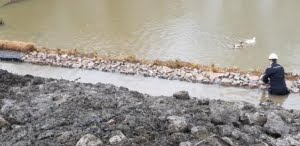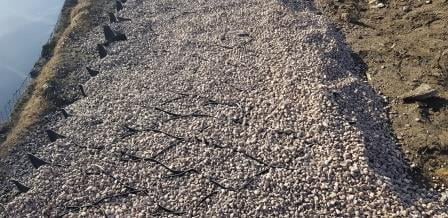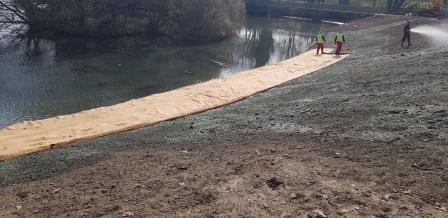Caerphilly Castle Silt Trap Clearance and Bank Rehabilitation
Welsh heritage service CADW, in association with Welsh Government and WSP consultants, appointed EDS to carry out a silt trap clearance within the moat of the prestigious Caerphilly Castle, and undergo further work to stabilise part of the moat embankment surrounding the castle.
Caerphilly Castle is a medieval fortification and is a scheduled monument, therefore the work undertaken had to be in accordance with the conditions of the Scheduled Monument Consent. The construction site was located on the south west corner of the castle moat, where the Nant Gledyr flows into the moat via a silt trap. Our construction site required the diversion of public footpaths around this part of the moat and was located directly opposite a local primary school on a busy main road with traffic calming measures, close to the town centre. These additional challenges were planned into the project design by the team in consultation with those affected, to ensure disruption to town traffic, peak school run times and tourists was where possible mitigated or minimised.
EDS set up a safety perimeter around the construction site to segregate the working area from the public and diverted sections of pedestrian footpaths around the site. The use of track mats, underlain with geotextile in the working areas protected the ground from damage. The marine life living in the moat also needed to be protected so a hessian silt containment and fish protection boom was installed, and any fish in the working area were removed prior to the commencement of the work by NRW. The work was scheduled during the winter months to avoid the nesting season of the abundant wildfowl that make the moat their home.
This work had two objectives, the first to excavate out accumulated material from the Silt Trap down to its base profile in order for the Silt Trap to resume effective functioning. Additional dredging of accumulated silt within the moat immediately downstream of the silt trap will help to improve moat water quality and optimise floodwater retention capacity. The second objective was to stabilise a section of the western moat bank to prevent further erosion and reprofile a section of overhanging bank that presented a safety risk.
Silt Trap Excavation
Excavation of the silt trap removed sandy silt to a bunded draining area within the silt trap, prior to removal off site by tipper lorries for soil recycling. All traffic movements had to be planned to avoid school drop off and pick up times, traffic marshals banked vehicles in and out of the site to ensure safe traffic movements did not present increased risk on the public highway. Once the silt trap has been excavated down to design levels, excavation of silt build up immediately downstream of the silt trap within the moat began. Due to the scheduled ancient monument consent, all excavation work within the moat required the presence of our approved Archaeologist to ensure no risk to the ancient monument was present. Apart from a buckled bike and a number of old bottles, unfortunately no historical artefacts were uncovered (but we’re sure it would have made for an interesting newspaper article read!)
Bank stabilisation Works
The moat embankment had become badly eroded resulting in certain high and overhanging areas which posed a risk to members of the public who fished and walked dogs around the moat banks.
To stabilise the embankment a trench was dug, again in the presence of our archaeologist and the spoil removed. Gabion baskets were placed and filled in-situ. Coir rolls pre-seeded with wetland plants were placed within the baskets, that will vegetate and grow to a few feet in height to protect the water’s edge. The void was backfilled with hardcore and spoil, then profiled to the height of the gabions to provide a gentle incline with a wetland planted edge, to reduce the risk of members of the public falling into the moat and reduce future bank erosion.
Towards the end of the project, the client requested additional surface stabilisation work prior to hydroseeding (hydraulic mulch seeding) to prevent slumping, ponding and run off of surface cover. This involved installing an Erosaweb system, which was then filled with stone chippings and covered with top soil then raked by hand until level. The client was concerned there would be a risk if the hydroseeding was done directly onto the soil it may wash out and therefore contaminate the moat. It was agreed Hessian Matting would be placed over the hydroseeded areas of the embankment which would prevent any wash out and stabilised the embankment surface. The hessian matting will protect the hydroseeding from wildlife especially birds, and also any adverse weather conditions.
This project was carried out very successfully by the team, who managed ever present challenges from weather, to public safety and delivered the project in a reduced timeframe to the original project. EDS feel privileged to be able to provide a service for our local beloved historical site, and therefore helping preserve it for generations to come.
















